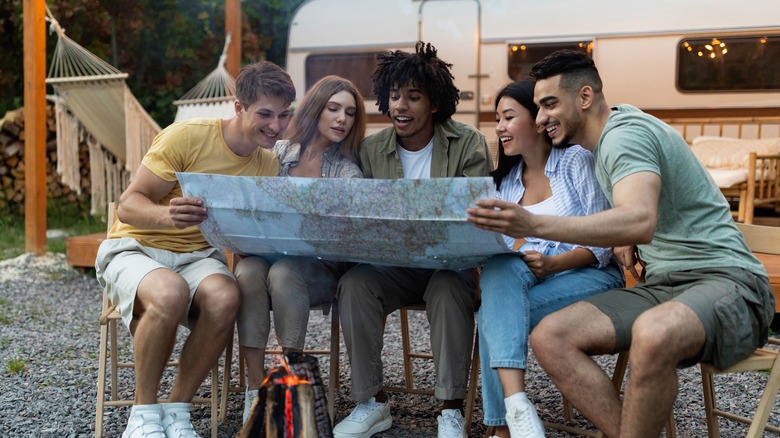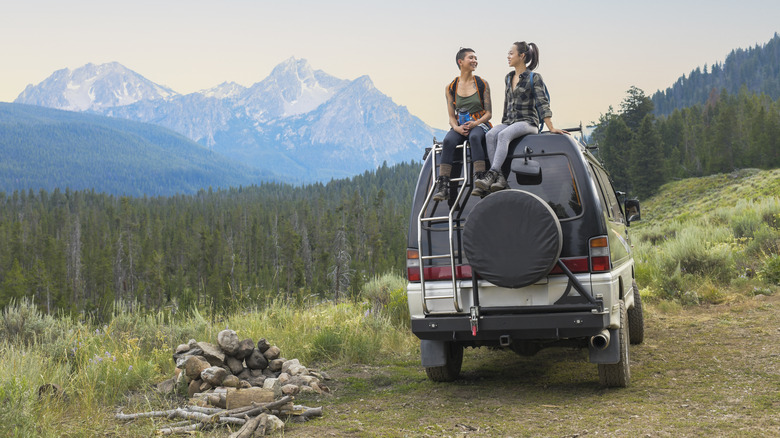How Younger Generations Are Changing The RV Camping Industry As We Know It
When the family comedy "RV" came out in 2006, it leaned hard into camper-van stereotypes: The family consists of a father, mother, daughter, and son. As the hapless patriarch, Robin Williams was in his mid-50s, and Cheryl Hines, playing his wife, was 40. Williams' protagonist spends much of his time worrying about a corporate career. Opposite them are another family, played by Jeff Daniels and Kristin Chenoweth, who have two sons and daughter. Every one of these actors is Caucasian and plays a heteronormative character. Naturally, the Munro family starts the film in a large suburban house.
Sure, "RV" is a wacky comedy, not a sociology paper, and if you really love jokes about geysers of human fecal matter, this movie makes for a perfect night in. But "RV" also speaks to our assumptions about RV users; these are the domains of hokey dads and housewives, plus the reluctant teenagers they drag along. The vehicle itself is basically the American Dream on wheels. The Munro family is able to drive long distances, which is fun, but the RV is also huge, unwieldy, and hard to maintain. We're led to believe that people who use campers are a little bit, well, campy.
But this expectation is rapidly changing. People investing in RVs are younger and more diverse than ever, and the vehicles come in an unprecedented range of makes, models, and functionalities. If you've considered preparing for your first RV road trip, you may find that there is no single "RV type," but a growing patchwork of demographics. For many folks, the open road is feeling more open than ever.
The evolving culture of RVs
Recreational vehicles date back over 100 years, and handy drivers have been retrofitting their cars for convenient camping since the early days of the automobile. One of the most important pioneers was Wally Byam, an Oregon-born inventor who founded the Airstream company in 1931. Nicknamed "Silver Bullets," the best known Airstream campers were chromed metal enclosures that road trippers could tow behind their cars. They looked futuristic and exciting, like spaceships landing in scenic forests. Other companies riffed on similar concepts, from the far-out Volkswagen buses of the late 1960s and early '70s to the mammoth Winnebagos from those decades onward.`
Social class has always lingered in the background of RV culture. For most Americans, an RV is an expensive toy, something you might buy toward the end of a successful and well paying career. Actually living in a mobile home might be cost-effective for some, but the very idea of "trailer parks" carries a lot of baggage. Families like the Munros in "RV" dominated the RV industry for decades, as many demographics did not feel welcome in National Parks or even on the road — hence the mid-century "Green Book," which safely guided African-American road trippers down Segregation-era highways.
But times seem to be changing: The news outlet Go RVing conducted an owner demographic survey in 2025, finding that the median age for RV owners is down from 53 to 49, and about one-third of new owners are "growth audiences," which it describes as "Hispanic-Americans, African Americans, Asian-Americans, and LGBTQ+." Interest in RVs is growing, and for several probable reasons.
How to get started RVing
Why are people turning to recreational vehicles? The Go RVing survey also found that about a quarter of people currently interested in buying an RV had rented one before. These kinds of vacation rentals have become more popular in recent years, and not just in the U.S. For example, a camper van is now considered the best affordable way to tour uncrowded parts of Japan. During the pandemic, many people turned to RVs as a safe and dynamic alternative to other forms of travel. The 2020 film "Nomadland" attracted audiences with its realistic portrayal of mobile living and won that year's Academy Award for Best Picture. Meanwhile, an army of influencers has converted vans into living spaces and capitalized on the hashtag #vanlife, making this freedom-loving lifestyle seem glamorous and accessible to a younger generation of Instagram users.
Technology has also improved safety and use. Drivers can navigate with GPS, install advanced security systems, use a mobile hotspot for devices, and power up in remote locations with solar kits. Entire apps are dedicated to overnighting in RVs, and the Internet is drenched in RV forums, catering to every interest, age group, and identity.
If you're curious about trying an RV for the first time, a rental is a good place to start. From there, prospective RV owners have to consider price, size, design, and intended use. Before you even try one out, here's what to know when renting an RV for a road trip.


